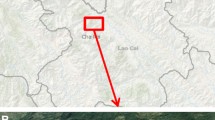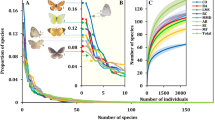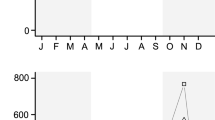Abstract
There are few papers describing long-term fluctuations and general patterns of temporal diversity in butterfly assemblages in the Neotropical region. The present paper presents a long-term study on the variation in richness and composition of butterflies in a fragment of semi-deciduous forest in Southeastern Brazil, and examines the viability of using maximized butterfly transect counts as a methodology to rapidly and adequately access the local characteristics of butterfly communities. Based on the eight annual standard lists, 518 species in six butterfly families were recorded, representing 74 % of the total butterfly fauna known from the study site. Hesperiidae was the richest family (248 species), followed by Nymphalidae (154), Lycaenidae (49), Riodinidae (29), Pieridae (26), and Papilionidae (12). The accumulation curves show that 8 years of sampling were not enough to result in stable species totals for all butterfly families, especially Hesperiidae and Lycaenidae, which are still increasing in number of species. A great similarity in species composition was observed among all the years (54 %). Comparing the similarity between two standard lists at different time intervals (from 1 to 8 years), a clear pattern of increasing dissimilarity was observed in most families. Our results show that the maximized sampling method is effective in revealing temporal patterns of diversity across several years and could be valuable in monitoring temporal variation in butterfly assemblages for conservation purposes, since the obtained standard lists can be successfully compared to temporal patterns over large periods of time.





Similar content being viewed by others
References
Basset Y, Eastwood R, Sam L, Lohman DJ, Novotny V, Treuer T, Miller SE, Weiblen GD, Pierce NE, Bunyavejchewin S, Sakchoowong W, Kongnoo P, Osorio-Arenas MA (2011) Comparison of rainforest butterfly assemblages across three biogeographical regions using standardized protocols. J Res Lepid 44:17–28
Bonebrake TC, Ponisio LC, Boggs CL, Ehrlich PR (2010) More than just indicators: a review of tropical butterfly ecology and conservation. Biol Conserv 143:1831–1841
Brown KS (1972) Maximizing daily butterfly counts. J Lepid Soc 26:183–196
Brown KS (1991) Conservation of neotropical environments: insects as indicators. In: Collins NM, Thomas JA (eds) The conservation of insects and their habitats. Academic Press, London, pp 350–404
Brown KS (1992) Borboletas da Serra do Japi: diversidade, hábitats, recursos alimentares e variação temporal. In: Morellato LPC (ed) História Natural da Serra do Japi: Ecologia e preservação de uma área florestal no sudeste do Brasil. Editora da UNICAMP, Campinas, pp 142–187
Brown KS (1993) Neotropical Lycaenidae: an overview. In: New TR (ed) Conservation biology of Lycaenidae (butterflies). IUCN, Gland, pp 45–61
Brown KS (2005) Geologic, evolutionary, and ecological bases of the diversification of neotropical butterflies: implications for conservation. In: Dick CW, Moritz G (eds) Tropical rainforest: past, present, and future. The University of Chicago Press, Chicago, pp 166–201
Brown KS, Freitas AVL (2000a) Diversidade de Lepidoptera em Santa Teresa, Espírito Santo. Bol Mus Biol Mello Leitão NS 11(12):71–116
Brown KS, Freitas AVL (2000b) Atlantic forest butterflies: indicators for landscape conservation. Biotropica 32(4b):934–956
Brown KS, Freitas AVL (2002) Butterfly communities of urban forest fragments in Campinas, São Paulo, Brazil: structure, instability, environmental correlates, and conservation. J Insect Conserv 6:217–231
Brown KS, Hutchings RW (1997) Disturbance, fragmentation, and the dynamics of diversity in Amazonian forest butterflies. In: Laurance WF, Bierregaard RO Jr (eds) Tropical forest remnants: ecology, management, and conservation of fragmented communities. University of Chicago Press, Chicago, pp 91–110
Caldas A, Robbins RK (2003) Modified Pollard transects for assessing tropical butterfly abundance and diversity. Biol Conserv 110:211–219
Callaghan CJ (1978) Studies on restinga butterflies. II. Notes on the population structure of Menander felsina (Riodinidae). J Lepid Soc 32:37–48
Colwell RK (2006) Estimates: Statistical estimation of species richness and shared species from samples. University of Connecticut. http://viceroy.eeb.ucon.edu/estimates. Accessed March 2011
Davies KF, Gascon C, Margules CR (2001) Habitat fragmentation. In: Soulé ME, Orinas GH (eds) Conservation biology. Research priorities for the next decade. Island Press, Washington, pp 81–97
DeVries PJ, Walla TR (2001) Species diversity and community structure in neotropical fruit-feeding butterflies. Biol J Linn Soc 74:1–15
DeVries PJ, Alexander LG, Chacon IA, Fordyce JA (2012) Similarity and difference among rainforest fruit-feeding butterfly communities in Central and South America. J Animal Ecol 81:472–482
Dunn RR (2005) Modern insect extinctions, the neglected majority. Conserv Biol 19:1030–1036
Ebert H (1969) On the frequency of butterflies in eastern Brazil, with a list of the butterfly fauna of Poços de Caldas. Minas Gerais. J Lepid Soc 23(Supplement 3):1–48
Hammer Ø, Harper DAT, Ryan PD (2001) Paleontological statistics—PAST. Version 2.02. http://folk.uio.no/ohammer/past. Accessed March 2011
Hong SK, Lee JA (2006) Global environmental changes in terrestrial ecosystems. International issues and strategic solutions: introduction. Ecol Res 21:783–787
Lamas G, Robbins RK, Harvey DJ (1991) A preliminary survey of the butterfly fauna of Pakitza, Parque Nacional del Manu, Peru, with an estimate of its species richness. Publicaciones del Museo de Historia Natural Universidad Nacional Mayor de San Marcos 40:1–19
Morellato RC, Leitão-Filho HF (1995) Ecologia e preservação de uma floresta tropical urbana; reserva Santa Genebra. Editora da UNICAMP, Campinas
Olson DM, Dinerstein E (2002) The global 200: priority ecoregions for global conservation. Ann Missouri Bot Gard 89:199–224
Pimm SL, Raven P (2000) Biodiversity—extinction by numbers. Nature 403:843–845
Pollard E (1977) A method for assessing changes in the abundance of butterflies. Biol Conserv 12:115–153
Pozo C, Luis-Martinez A, Llorente-Bousquets J, Salas-Suárez N, Maya-Martínez A, Vargas-Fernández I, Warren AD (2008) Seasonality and phenology of the butterflies (Lepidoptera: Papilionoidea and Hesperioidea) of Mexico’s Calakmul region. Fla Entomol 91:407–422
Ribeiro DB, Freitas AVL (2010) Differences in thermal responses in a fragmented landscape: temperature affect the sampling of diurnal, but not nocturnal fruit-feeding Lepidoptera. J Res Lepid 42:1–4
Robbins RK, Small GB (1981) Wind dispersal of Panamanian hairstreak butterflies (Lepidoptera: Lycaenidae) and its evolutionary significance. Biotropica 13:308–315
Robbins RK, Lamas G, Mielke OHH, Harvey DJ, Casagrande MM (1996) Taxonomic composition and ecological structure of the species-rich butterfly community at Pakitza, Parque Nacional del Manu, Peru. In: Wilson DE, Sandoval A (eds) Manu: the biodiversity of southeastern Peru. Smithsonian Institution Press, Washington, pp 217–252
Uehara-Prado M, Brown KS, Freitas AVL (2007) Species richness, composition and abundance of fruit-feeding butterflies in the Brazilian Atlantic forest: comparison between a fragmented and a continuous landscape. Global Ecol Biogeogr 16:43–54
Vanini F, Bonato V, Freitas AVL (1999) Polyphenism and population biology of Eurema elathea (Pieridae) in a disturbed environment in tropical Brazil. J Lepid Soc 53:159–168
Veddeler D, Schulze CH, Steffan-Dewenter I, Buchori D, Tscharntke T (2005) The contribution of tropical secondary forest fragments to the conservation of fruit-feeding butterflies: effects of isolation and age. Biodiv Conserv 14:3577–3592
Whitmore TC (1997) Tropical forest disturbance, disappearance, and species loss. In: Laurence WF, Bierregaard RO Jr (eds) Tropical forest remnants. University of Chicago Press, Chicago, pp 2–28
Acknowledgments
We thank the Fundação José Pedro de Oliveira for providing logistic support for field work in the Santa Genebra forest Reserve. We also thank Leonardo Ré Jorge, Lucas Kaminski, Danilo B. Ribeiro and Keith Willmott for suggestions in a previous version of the manuscript. CAI was supported by the Brazilian Research Council—Conselho Nacional de Desenvolvimento Científico e Tecnológico (CNPq) until September/2011 and now is supported by Fundação de Amparo à Pesquisa do Estado de São Paulo (FAPESP, 2011/08433-8). AVLF was supported by the FAPESP grant 04/05269-9, and the Brazilian CNPq (300282/2008-7). This publication is part of the RedeLep “Rede Nacional de Pesquisa e Conservação de Lepidópteros” SISBIOTA-Brasil/CNPq (563332/2010-7), and of the BIOTA-FAPESP Program (2011/50225-3).
Author information
Authors and Affiliations
Corresponding author
Rights and permissions
About this article
Cite this article
Iserhard, C.A., Brown, K.S. & Freitas, A.V.L. Maximized sampling of butterflies to detect temporal changes in tropical communities. J Insect Conserv 17, 615–622 (2013). https://doi.org/10.1007/s10841-013-9546-z
Received:
Accepted:
Published:
Issue Date:
DOI: https://doi.org/10.1007/s10841-013-9546-z




